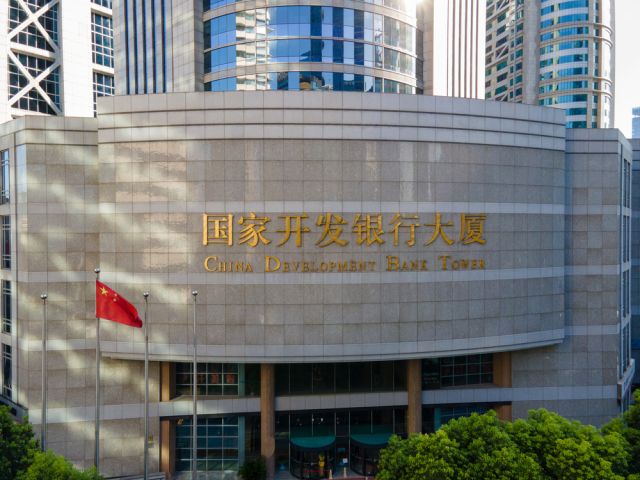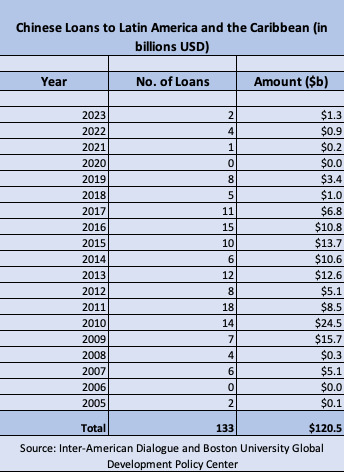
Between 2005-2023, China Development Bank and Export-Import Bank of China provided $120 billion via 133 loan commitments to countries across Latin American and the Caribbean (LAC) and state-owned enterprises. (Source: Shutterstock)
China will not be resuming the mega oil-backed leaning of yesteryear as its focus turns to debt negotiations, according to the Inter-American Dialogue (IAD) and the Boston University (BU) Global Development Policy Center.
A decade ago, Chinese lending to the Latin American-Caribbean region surpassed lending from the World Bank and the Inter-American Development Bank (IDB).
Between 2005-2023, China Development Bank (CDB) and Export-Import Bank of China (Ex-Im Bank) provided $120 billion via 133 loan commitments to countries across Latin American and the Caribbean (LAC) and state-owned enterprises, IAD and BU said June 18 in a joint press release announcing the results of a recent study.
Of the $120 billion, energy projects investments were $94.1 billion or 78% of the total followed by other ($12.1 billion), infrastructure ($12.1 billion) and mining ($2.1 billion). By region, the distributions were destined to four countries with received 92% of the financing: Venezuela ($59.2 billion, 49%), Brazil ($32.4 billion, 27%), Ecuador ($11.8 billion, 10%) and Argentina ($7.7 billion, 6%).
But now, lending from the World Bank and IDB to the Latin America-Caribbean region has surpassed lending from Chinese financing institutions, the IAD and BU said in the release.

“As in previous years, there is little to indicate a resurrection of the multibillion-dollar, oil-backed lending that once characterized the bulk of China’s financial engagement with the region,” the IAD and BU said in the release.
However, the CDB and Ex-Im Bank will remain committed to issuing smaller loans more closely linked to Chinese and host country development objectives. Such loans could be for transport infrastructure development or generating investment and trade in priority-emerging industries, the release said.
“The next few years will be marked by debt negotiations between China and its debtors in the region, but also by continued recalibration as China adjusts its domestic economic policy and as the Belt and Road Initiative (BRI) and related finance and investment follow suit,” IAD and BU said in the release.
In the Latin America-Caribbean region, only Suriname reported debt levels to Chinese creditors of over 5% of GDP or projected debt service payments amounting to over 2% of projected exports over the next 5 years.
Chinese companies—now well established in much of the area—are no longer dependent on development finance institutions loans to generate opportunities for their involvement in infrastructure projects. With CDB and Ex-Im Bank focused on debt reduction, China’s smaller commercial banks have increasingly stepped into the fold through syndicated loans to Chinese or LAC companies.
Recommended Reading
TotalEnergies to Invest $400MM in LPG
2024-05-14 - TotalEnergies is investing more than $400 million into LPG to provide more than 100 million people in Africa and Asia access to clean cooking methods by 2030.
Sunoco’s $7B Acquisition of NuStar Evades Further FTC Scrutiny
2024-04-09 - The waiting period under the Hart-Scott-Rodino Antitrust Improvements Act for Sunoco’s pending acquisition of NuStar Energy has expired, bringing the deal one step closer to completion.
Petrobras CEO Prates to Step Down
2024-05-15 - Brazil’s President Luiz Inácio Lula da Silva has requested that Petrobras CEO Jean Paul Prates resign following a dispute over dividend payments.
China Not Continuing Mega Oil-backed Loans to Latin America
2024-06-18 - China, which lent around US$120 billion to Latin America and the Caribbean between 2005-2023, isn’t expected to resume the mega oil-backing loans of yesteryear as the focus turns to debt negotiations.
PrairieSky Adds $6.4MM in Mannville Royalty Interests, Reduces Debt
2024-04-23 - PrairieSky Royalty said the acquisition was funded with excess earnings from the CA$83 million (US$60.75 million) generated from operations.





